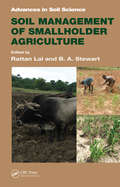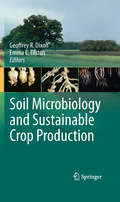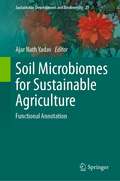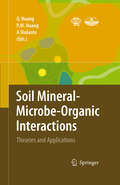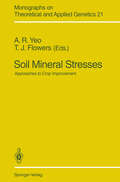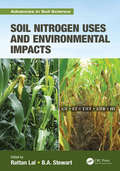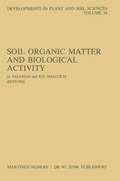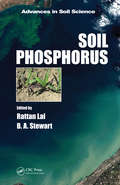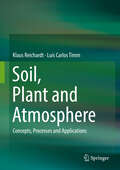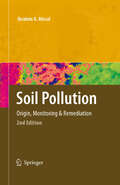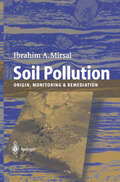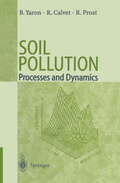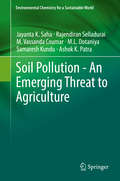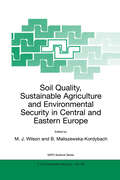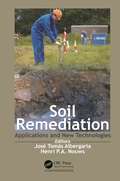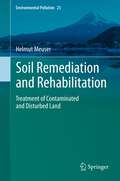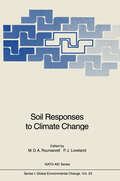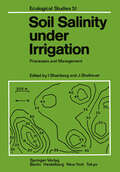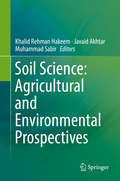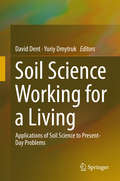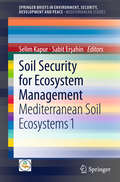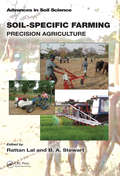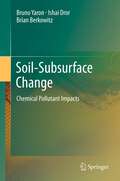- Table View
- List View
Soil Management of Smallholder Agriculture
by Rattan Lal B. A. StewartNearly two billion people depend on hundreds of millions of smallholder farmers for food security. Yet, these farmers' lives also hang in the balance due to their extreme vulnerability to the risks of soil degradation and depletion, soil exhaustion, climate change, and numerous biotic and abiotic stresses. Soil Management of Smallholder Agriculture
Soil Microbiology and Sustainable Crop Production
by Geoffrey R. R. Dixon Emma L. L. TilstonSoils into which crop plants root and from which they obtain essential minerals and water contain huge arrays of microbes. Many have highly beneficial effects on crop growth and productivity, others are pathogens causing diseases and losses to yield and quality, a few microbes offer protection from these pathogenic forms and others have little or no effect. These intimate and often complex inter-relationships are being explored with increasing success providing exciting opportunities for increasing crop yields and quality in sustainable harmony with the populations of beneficial soil microbes and to the detriment of pathogens. This book explores current knowledge for each of these aspects of soil microbiology and indicates where future progress is most likely to aid in increasing crop productivity by means which are environmentally benign and beneficial.
Soil Microbiomes for Sustainable Agriculture: Functional Annotation (Sustainable Development and Biodiversity #27)
by Ajar Nath YadavThis book encompasses current knowledge of soil microbiomes and their potential biotechnological application for plant growth, crop yield, and soil health under the natural as well as harsh environmental conditions for sustainable agriculture. The microbes are ubiquitous in nature. The soil is a natural hotspot of the soil microbiome. The soil microbiome plays a critical role in the maintenance of global nutrient balance and ecosystem functioning. The soil microbiomes are associated with plant ecosystems through the intense network of plant–microbe interactions. The microbes present in bulk soil move toward the rhizospheric region due to the release of different nutrients by plant systems. The rhizospheric microbes may survive or proliferate in rhizospheric zone depending on the extent of influences of the chemicals secreted into the soil by roots. The root exudates contain the principal nutrients factors (amino acids, glucose, fructose, and sucrose). The microbes present in rhizospheric region have capabilities to fix atmospheric nitrogen, produce different phytohormones, and solubilize phosphorus, potassium, and zinc. The plant systems take these nutrients for their growth and developments. These soil and plant associated microbes also play an important role in protection of plants from different plant pathogenic organisms by producing different secondary metabolites such as ammonia, hydrogen cyanide, siderophores, and hydrolytic enzymes. The soil microbiomes with plant growth-promoting (PGP) attributes have emerged as an important and promising tool for sustainable agriculture. The soil microbiomes promote the plant growth and enhance the crop yield and soil fertility via directly or indirectly different plant growth-promoting mechanism. The soil microbes help the plant for adaptation in extreme habitats by mitigating the abiotic stress of high/low temperatures, hypersalinity, drought, and acidic/alkaline soil. These PGP microbes are used as biofertilizers/bioinoculants to replace the harmful chemical fertilizers for sustainable agriculture and environments.The aim of the book “Soil Microbiomes for Sustainable Agriculture” is to provide the recent advances in mechanisms of plant growth promotion and applications of soil microbiomes for mitigation of different abiotic stresses in plants. The book is useful to scientists, researchers, and students related to microbiology, biotechnology, agriculture, molecular biology, environmental biology, and related subjects.
Soil Mineral -- Microbe-Organic Interactions: Theories and Applications
by Qiaoyun Huang Pan Ming Huang Antonio ViolanteThe book presents the latest research findings and prospects on soil mineral-organic matter-microorganism interactions. It includes topics covering mechanisms of transformations, dynamics and bioavailability of heavy metals, radionuclides, biomolecules and nutrients immobilized on soil minerals, humic substances, mineral-humic complexes and microorganisms and their impact on plant, animal and human health. The book is organized into six parts.
Soil Mineral Stresses: Approaches to Crop Improvement (Monographs on Theoretical and Applied Genetics #21)
by Anthony R. Yeo Timothy J. FlowersSoil Nitrogen Uses and Environmental Impacts (Advances in Soil Science)
by Rattan Lal B. A. StewartNitrogen (N) is potentially one of the most complex elements on the Earth. It is necessary for all biological activity, but creates negative impacts on water and air quality. There is a balancing act between deficiency and surplus and the forms of N available further complicate our understanding of the dynamics. Biological fixation provides some plants with N supply while others are totally dependent upon N being available in the soil profile for the roots to extract. Nevertheless, the demand for N will increase because the human population with its increasing growth requires more protein and thus more N. Understanding the global N cycle is imperative to meeting current and future nitrogen demands while decreasing environmental impacts. This book discusses availability, production, and recycling of N in air, water, plants, and soils. It features information on N impacts to soil and water quality, management of N in agroecosystems, and techniques to maximize the use efficiency while minimizing the risks of leakage of reactive N into the environment. This volume in the Advances in Soil Science series is specifically devoted to availability, production, and recycling of N with impact on climate change and water quality, and management of N in agroecosystems in the context of maximizing the use efficiency and minimizing the risks of leakage of reactive N (NO-3, N¬2O) into the environment.
Soil Nitrogen Uses and Environmental Impacts (Advances in Soil Science)
by Rattan Lal B. A. StewartNitrogen (N) is potentially one of the most complex elements on the Earth. It is necessary for all biological activity, but creates negative impacts on water and air quality. There is a balancing act between deficiency and surplus and the forms of N available further complicate our understanding of the dynamics. Biological fixation provides some plants with N supply while others are totally dependent upon N being available in the soil profile for the roots to extract. Nevertheless, the demand for N will increase because the human population with its increasing growth requires more protein and thus more N. Understanding the global N cycle is imperative to meeting current and future nitrogen demands while decreasing environmental impacts. This book discusses availability, production, and recycling of N in air, water, plants, and soils. It features information on N impacts to soil and water quality, management of N in agroecosystems, and techniques to maximize the use efficiency while minimizing the risks of leakage of reactive N into the environment. This volume in the Advances in Soil Science series is specifically devoted to availability, production, and recycling of N with impact on climate change and water quality, and management of N in agroecosystems in the context of maximizing the use efficiency and minimizing the risks of leakage of reactive N (NO-3, N¬2O) into the environment.
Soil Organic Matter and Biological Activity (Developments in Plant and Soil Sciences #16)
by D. Vaughan R. E. MalcolmIt has long been recognized that soil organic matter is the key to soil fertility. As a nutrient store it gradually provides essential elements which the soil cannot retain for long in inorganic form. It buffers growing plants against sudden changes in their chemical environment and preserves moisture in times of drought. It keeps the soil in a friable, easily penetrated physical condition, well-aerated and free draining, providing young seedlings with an excellent medium for growth. But it has another property, the nature and extent of which have been the subject of argu ment and controversy ever since scientists began to study the soil, and that is its ability to affect growth directly, other than by providing nutrient elements. Any one wishing to learn about these effects has been faced with a daunting mass of literature, some confusing, often contradictory, and spread through a multitude of journals. Individual aspects have been covered from time to time in reviews but there has obviously been a need for a modern authoritative text book dealing with the many facets of this subject, so the publication of this volume is timely. The editors and authors are all specialists in their fields, fully familiar with the com plex nature of soil organic matter and with the particular difficulties arising in any study of its properties. Where controversies exist they have presented all sides of the argument and have highlighted areas where further work is badly needed.
Soil Phosphorus (Advances in Soil Science)
by Rattan Lal B. A. StewartPhosphorus is an essential plant nutrient, but global population growth has dramatically reduced the availability of phosphorus fertilizer resources. Despite this scarcity, there remain numerous problems associated with the excessive and inappropriate use of phosphorus leading to non-point source pollution and eutrophication of natural waters. Identifying appropriate systems for managing soil phosphorus and reducing the risks of eutrophication are needed to minimize the environmental risks. This book focuses on the availability and recycling of phosphorus; regulatory and policy issues of sustainable phosphorus use; and water quality management in agroecosystems pertaining to phosphorus. Sections are dedicated to global phosphorus reserves; cycling and pathways of phosphorus; phosphorus in agriculture; human dimensions and policy intervention; and research and development priorities. Phosphorus is a finite but crucial resource and is an essential element to all life. Sub-optimal availability and nutrient imbalance in the root zone can adversely impact plant growth, and the quality of food and feed grown on these soils. However, the proven reserves of phosphorus can hardly be adequate for a few centuries only. Yet, its misuse and mismanagement has caused severe problems of eutrophication of water and pollution of the environment. Thus, judicious management of soil phosphorus is essential. This volume is specifically devoted to availability and recycling of phosphorus, regulatory/policy issues of sustainable use of phosphorus, and management in agroecosystems in the context of maximizing the use efficiency and minimizing the environmental risks of water quality.
Soil Phosphorus (Advances in Soil Science)
by Rattan Lal B. A. StewartPhosphorus is an essential plant nutrient, but global population growth has dramatically reduced the availability of phosphorus fertilizer resources. Despite this scarcity, there remain numerous problems associated with the excessive and inappropriate use of phosphorus leading to non-point source pollution and eutrophication of natural waters. Identifying appropriate systems for managing soil phosphorus and reducing the risks of eutrophication are needed to minimize the environmental risks. This book focuses on the availability and recycling of phosphorus; regulatory and policy issues of sustainable phosphorus use; and water quality management in agroecosystems pertaining to phosphorus. Sections are dedicated to global phosphorus reserves; cycling and pathways of phosphorus; phosphorus in agriculture; human dimensions and policy intervention; and research and development priorities. Phosphorus is a finite but crucial resource and is an essential element to all life. Sub-optimal availability and nutrient imbalance in the root zone can adversely impact plant growth, and the quality of food and feed grown on these soils. However, the proven reserves of phosphorus can hardly be adequate for a few centuries only. Yet, its misuse and mismanagement has caused severe problems of eutrophication of water and pollution of the environment. Thus, judicious management of soil phosphorus is essential. This volume is specifically devoted to availability and recycling of phosphorus, regulatory/policy issues of sustainable use of phosphorus, and management in agroecosystems in the context of maximizing the use efficiency and minimizing the environmental risks of water quality.
Soil, Plant and Atmosphere: Concepts, Processes and Applications
by Klaus Reichardt Luís Carlos TimmThis textbook presents the concepts and processes involved in the soil-plant-atmosphere system as well as its applications in the water cycle in agriculture. Although reaching the frontier of our knowledge in several subjects, each chapter starts at the graduation level and proceeds to the post-doctoral level. Its more complicated subjects, as math and physics, are well explained, even to readers not well acquainted with these tools. Therefore, it helps students read, understand, and developing their thoughts on these subjects. Instructors also find it an easy book with the needed depth to be adopted in courses related to Soil Physics, Agricultural Management, Environmental Protection, Irrigation and Agrometeorology. It serves also as “lexicon” to engineers and lawyers involved in agricultural, environmental cases.
Soil Pollution: Origin, Monitoring & Remediation
by Ibrahim MirsalDespite having been published about two years ago for the first time, the continuous demand for this book encouraged me to prepare this revised and enlarged edition. Many parts of the text have been rewritten, type errors traced and corrected, and the bibliography largely modified to include many of the references published about the subject of soil pollution in the previous ten years. I should like to express my thanks to the staff of Springer-Verlag, Heidelberg, for their cooperative efforts in preparing this edition. I also would like to thank Mr. Michael Sidwell (B.A.) for the extreme but characteristic care with which he read and revised the proofs. I hope that, in this new edition, the book may continue to serve the needs of students and professionals alike interested in the subject of soil pollution. Ibrahim A. Mirsal Preface to the First Edition Whoever has enjoyed following the legendary duel between the Egyptian Pharaoh and his magicians (Alchemists) on one side, and Moses and his brother Aaron on the other, as is vividly narrated in the Bible, must have realised that people (at least those living at, or near the eternal battlefields of the Middle East) have always had knowledge about the terrible consequences of soil pollution by chemicals. This knowledge must have existed long before Moses and his Pharaoh. Nobody knows when people became aware of this, yet it must have been born in very early times, reaching back to the dawn of human conscious.
Soil Pollution: Origin, Monitoring & Remediation
by Ibrahim MirsalThis graduate-level text and reference work is unique among the soil literature. It deals with the interdisciplinary fields of soil pollution and remediation. It starts off with a thorough and comprehensible introduction to the relevant fundamentals of mineralogy, chemistry, and soil properties. Readers are thus well prepared to understand the biochemical aspects of soil remediation then presented. The book’s holistic approach and narrative style are complemented by numerous and detailed illustrations. Soil pollution is an asset not only to graduate students and instructors, but also to professionals from the environmental and agricultural sciences, as it provides an integrated overview of previously separately treated material.
Soil Pollution: Processes and Dynamics
by Bruno Yaron Raoul Calvet Rene ProstThe soil is the medium through which pollutants originating from human activities, both in agriculture and industry, move from the land surfaces to groundwater. Polluting substances are subject to complex physical, chemical and biological transformations during their movement through the soil. Their displacement depends on the transport properties of the water-air-soil system and on the molecular properties of the pollutants. Prediction of soil pollution and restoration of polluted soils requires an under standing of the processes controlling the fate of pollutants in the soil medium and of the dynamics of the contaminants in the un saturated zone. Our book was conceived· as a basic overview of the processes governing the behavior of pollutants as affected by soil constituents and environmental factors. It was written for the use of specialists working on soil and unsaturated zone pollution and restoration, as well as for graduate students starting research in this field. Since many specialists working on soil restoration lack a back ground in soil science or a knowledge of the properties of soil pollutants, we have included this information which forms the first part of the book. In the second part, we discuss the partitioning of pollutants between the aqueous, solid and gaseous phase of the soil medium. The retention, transformation and transport of pollutants in the soils form the third section.
Soil Pollution - An Emerging Threat to Agriculture (Environmental Chemistry for a Sustainable World #10)
by Jayanta K. Saha Rajendiran Selladurai M. Vassanda Coumar M. L. Dotaniya Samaresh Kundu Ashok K. PatraThe book provides reader with a comprehensive up-to-date overview of various aspects of soil pollutants manifestation of toxicity. The book highlights their interactions with soil constituents, their toxicity to agro-ecosystem & human health, methodologies of toxicity assessment along with remediation technologies for the polluted land by citing case studies. It gives special emphasis on scenario of soil pollution threats in developing countries and ways to counteract these in low cost ways which have so far been ignored. It also explicitly highlights the need for soil protection policy and identifies its key considerations after analyzing basic functions of soil and the types of threats perceived. This book will be a useful resource for graduate students and researchers in the field of environmental and agricultural sciences, as well as for personnel involved in environmental impact assessment and policy making.
Soil Quality, Sustainable Agriculture and Environmental Security in Central and Eastern Europe (NATO Science Partnership Subseries: 2 #69)
by M. J. Wilson B. Maliszewska-KordybachAgriculture is a crucial component of the economies of many of the countries in transition from a centrally-planned to a market economy and the sector is by no means immune to the environmental and socioeconomic problems confronting the countries as a whole. The concept of sustainable development provides a convenient framework for the formulation of government environmental policy for such countries, especially those of them that aspire to join the EU and would thus be expected to meet EU environmental standards. For agriculture, this inevitably involves appropriate strategies for balancing crop and animal production while protecting the quality of the national soil and water resources. There is thus an urgent need to compile, exchange and evaluate current information on the quality of soils in these countries, and to assess the potential impact of new management practices on the soil and on the wider environment.
Soil Remediation: Applications and New Technologies
by Jose T. V. S. De Albergaria Hendrikus P. A. NouwsSoil contamination represents a serious environmental problem and requires an immediate action plan to be prepared for typical and emergent contaminants. This book provides an overview of some remediation technologies, both traditional and emergent, as well as case studies based on the contribution from academia and service providers. Several soil
Soil Remediation and Rehabilitation: Treatment of Contaminated and Disturbed Land (Environmental Pollution #23)
by Helmut MeuserThis book provides a comprehensive overview of remediation and rehabilitation techniques and strategies for contaminated and anthropogenically disturbed land. Rehabilitation approaches in the urban environment, such as brownfield redevelopment and urban mining, are discussed. In relation to contaminated land, techniques for soil containment and decontamination of soil, soil vapour and groundwater are comprehensively and systematically presented. Complicated treatment techniques are schematically depicted and can be readily understood. Agricultural, silvicultural and environmentally sustainable rehabilitation strategies for reclaiming disturbed land/terrain in former mining or natural-resource extraction areas, such as open-cast mines, quarries, harvested peatlands, and subsided mining terrain (sinkholes), are introduced. This book will be a useful tool for students, researchers, private consultants and public authorities engaged in the treatment of contaminated or disturbed land.
Soil Responses to Climate Change (Nato ASI Subseries I: #23)
by Mark D. A. Rounsevell Peter J. LovelandSoils will play a central role in mediating the impact of climate change on natural and managed ecosystems. The book addresses the various responses of soil processes and properties to environmental change and highlights their contribution to the proper understanding of ecosystem behaviour.Topics include: Soil hydrology; landscape evolution; salinisation; desertification; soil nitrogen dynamics; soil carbon; soil microbiology; soil erosion; crop modelling.
Soil Salinity under Irrigation: Processes and Management (Ecological Studies #51)
by I. Shainberg J. ShalhevetThe importance of irrigation in the world's agriculture is rapidly increasing. Although it is practised on a large scale mainly in arid and semi-arid zones, supplementary irrigation is becoming popular in semi-humid regions as well. The record of irrigation speaks for itself in terms of increased crop production. However, the question remains as to how permanent the achievement may be. Judging from history, it seems that irrigation eventually failed in many regions because the knowledge and technology available to society at the time were incapable of coping with the problems created. Undoubtedly soil salinity is the most prevalent and widespread problem limiting crop productivity in irrigated agriculture. It has, therefore, attracted the attention of the scientific community since the advent of modern agronomic research. Through the past six to seven decades a considerable body of information has been accumulated, which has promoted the understanding of the principles involved and helped to develop the technology for coping with the problems. Our present knowledge, if judiciously applied, is adequate for coping with many of the salinity problems resulting from mismanagement of irrigation and drainage. But for this knowledge to be used, it has to be generally known and understood and be re-examined from time to time.
Soil Science: Agricultural and Environmental Prospectives
by Khalid Rehman Hakeem Javaid Akhtar Muhammad SabirSoil is the most important natural non-renewable resource developed over a longer period of time due to weathering of rocks and subsequently enrichment of organic matter. Soil provides habitat for numerous microorganisms and serves as a natural medium for plant growth, thereby providing the plants with anchorage, nutrients and water to sustain the growth. Soil also serves as a universal sink for all types of pollutants, purifies ground water and is a major reserve of carbon in the universe. The role of soils to provide ecosystem services, maintenance of environmental/human health and ensuring the food security makes it as the most important and basic natural resource. Soil Science helps us to elaborate and understand how the soils provide all these services. Soil Science also provides us the basic knowledge dealing with the origin of the soil parent material, weathering of parent material and the formation of soils, morphological, physico-chemical and biological features of soils, classification of soils and role of soils in the provision and maintenance of ecosystem services, food security and environmental quality. This book encompasses the various processes, functions and behaviour of soils very comprehensively to acquaint the students of soil, plant and environmental sciences about their role to perform different agricultural and environmental functions.
Soil Science Working for a Living: Applications of soil science to present-day problems
by David Dent Yuriy DmytrukThis book discusses gritty issues that society faces every day: food and water security, environmental services provided by farmers, almost accidentally, and taken for granted by everyone else, the capability of the land to provide our needs today and for the foreseeable future and pollution of soil, air and water. The chapters are grouped in four main themes: soil development - properties and qualities; assessment of resources and risks; soil fertility, degradation and improvement and soil contamination, monitoring and remediation. It is a selection of papers presented at the Pedodiversity in Space and Time Symposium held at Chernivtsi National University, Ukraine, 15-19 September 2015.
Soil Security for Ecosystem Management: Mediterranean Soil Ecosystems 1 (SpringerBriefs in Environment, Security, Development and Peace #8)
by Selim Kapur Sabit ErşahinThe term "Soil Security" is used in the context of maintaining the quality and quantity of soil needed in order to ensure continuous supplies of food and fresh water for our society. Topics in this unique book on the management of soil sustainability in the Mediterranean region include: soil information, land degradation, land desertification, pedoenvironments, and the carbon cycle and sequestration. One main focus of the book is the description of new approaches that have been adapted with regards to interdisciplinary soil ecosystem management to combat and mitigate desertification. The contributing authors are renowned experts in their fields which cover the subjects on traditional as well as innovative land use and management.
Soil-Specific Farming: Precision Agriculture (Advances In Soil Science Ser.)
by Rattan Lal B. A. StewartFaced with challenges of resource scarcity and environmental degradation, it is important to adopt innovative farming systems that maximize resource efficiency while protecting the environment. Soil-Specific Farming: Precision Agriculture focuses on principles and applications of soil-specific farming, providing information on rapidly evolving agri
Soil-Subsurface Change: Chemical Pollutant Impacts
by Bruno Yaron Ishai Dror Brian BerkowitzThis book combines soil science, earth science, and environmental geochemistry, providing comprehensive background information for specialists interested in chemical-induced changes in the soil-subsurface system. Readers are introduced to the chemistry of contaminants that often disturb the natural soil-subsurface equilibrium as a result of human activity. While the soil-subsurface system has in many cases been affected by human impact, the effects of chemical contaminants on the actual matrix and properties have been largely neglected. The major focus of the book is on changes to the soil-subsurface matrix and properties caused by chemical pollution. By integrating results available in the literature, we observe that chemical pollutants may lead to the irreversible formation of a new soil-subsurface regime characterized by a matrix and properties different than those of the natural regime. In contrast to the geological time scales dictating natural changes to the matrix and properties of the soil-subsurface system, the time scale associated with chemical pollutant-induced changes is far shorter and extends over a “human lifetime scale.” The numerous examples presented in the book confirm that chemical contamination should be considered as an additional factor in the formation of a contemporary soil-subsurface regime that is different than that of the pristine system.
